-
Pang Ho-cheung: Love in a Puff (2010)
Pang Ho-cheung: Love in a Puff (2010)

Miriam Yeung Chin Wah and Shawn Yue in Love in a Puff
Smoking restrictions lead to urban romance
The girl has mauve hair, an indication of the hipness of this couple who first meet on a smoke break in a Hong Kong alleyway. He's in advertising; she sells cosmetics. And his shirt is the same color, signaling an affinity this movie seeks to explore. A Hong Kong ordinance prohibited smoking in all indoor areas. Employees began gathering in cliques they called "hot pot packs" to smoke outdoors, talk, and have fun. That's the starting point. There's much camaraderie and banter -- liberally laced with profanity -- among the "hot pot pack" that includes a man with round glasses, a girl with a knit cap, a Pakistani pizza man, a little uniformed hotel bellman -- and the couple-to-be, Jimmy (Shawn Yue) and Cherie (Miriam Yeung Chin Wah). The movie begins with a dramatization of a shaggy dog story about a man locked in car trunk in a parking lot who turns out to be a ghost. There's a lot of joking round, and things stay very light, becoming just a little romantic when Jimmy joins Cherie at a costume birthday party at a Karaoke bar -- except Cherie turns out to have a boyfriend, KK (Jo Kuk).
Eventually he finds out about Jimmy (and we see how much fun he and Cherie are having together) and he gets jealous. Love in a Puff shows how romantic text messaging can be -- and how it can give away secrets if spied on. And when Cherie decides to switch to Jimmy's network so her SMS fees aren't too high, Jimmy's cohorts at work say she's too aggressive. Jimmy has just had a breakup with a girlfriend at work, and Cherie is older. These are the givens that do nothing but fuel the mutual attraction.
This movie excels in its constant interplay of lightness and seriousness, in the way the milieu and the social world is sketched in, and in the great chemistry between Yeung and Yue. Their dialogue is breezy and sometimes touching. Dialogue in group scenes is feisty and provocative by sometimes strict Hong Kong standards; Love in a Puff caused some controversy, which could add to its hip gloss for locals. Some of the whimsy recalls romantic moments in Wong Kar-wai; it's all more mundane, but enough to show that Wong's tropes are far from unique and sometimes come from Hong Kong pop culture.
If only Pang had taken more breaks from the sit-com charm and stepped back a little, he might have created a bit more magic. There is a hint of that in a silhouette-and-full-moon sequence of Cherie at the 80-minute mark, when the story reaches its make-or-break get-serious point. At film's end, the couple come to some kind of commitment, with Jimmy's Land Rover stalled on an overpass, appropriately enough by making serious plans to both give up smoking, and focus on each other.
The apparent triviality of the subject matter, along with the modern urban couple's difficulty with communication (despite multiple platforms) is offset by wit and keen observation of little details every step of the way. This light, cinematic, amusing movie is appealing and fresh -- and has an assured polish, along with casual touches, like the little small-screen 16mm interviews that serve as occasional commentary. All in all, Love in a Puff is a delightful little piece of fluff, as casual as its lovers try to be. An online critic, listing this as one of his top movies of 2010, characterized it as "forgettable in an unforgettable way," and that's about right. Not all will like this; Asian film critic Derek Elley called it "peculiarly pointless" and "progressively boring." Local commentaries say the film won't work dubbed in Mandarin because its Cantonese profanities are untranslatable and had the audiences in stitches throughout. Subtleties apart, the English titles give a fair sense of this pungency. Some little SMS tricks emerge too: for instance, if you type "i n 55!W !" it looks like nonsense or code, but turn the phone upside down and it reads "I MISS U!" Of such details are Puff's flavor and charm made.
After its initially rocky debut in Hong Kong due to its profanity and heavy nicotine use, Love in a Puff has breezed along the festival route, appearing in Seattle, Melbourne, Tokyo, Palm Springs, landing in April 2011 at the San Francisco International Film Festival, where it was screened for this review. The original Chinese title is Chi ming yu chun giu/志明與春嬌 which means simply Jimmy and Cherie. I was not previously familiar with the work of this prolific 2000's Hong Kong director.
Love in a PUff, 101 mins., opened in Hong Kong 24 March 2010.It was screened for this review as part of the 2011 San Francisco International Film Festival, where it showed 28 and 30 April 2011.
Last edited by Chris Knipp; 05-05-2015 at 11:54 AM.
-
Park Jung-bum: The Journals of Musan (2010)
Park Jung-bum: The Journals of Musan (2010)
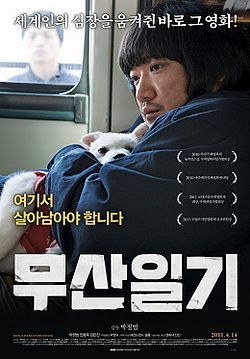
PARK JUNG-BUM IN THE JOURNALS OF MUSAN
Study of an outcast
Park Jung-bum served as assistant director on Lee Chang-dong's outstanding recent film, Poetry (NYFF 2010). In this strong directorial debut he focuses on the plight of a North Korean refugee from Musan in the South Hamgyeong Province struggling to scrape together an existence in South Korea. Jeong Seung-chul (Park Jung-bum himself), who has just emerged from eight months in a resettlement camp, lives at the edge of a demolition pit in the sprawling outskirts of Seoul. The 125 prefix on his ID card number tells potential employers he's a defector from up there, and hence undesirable. All Seung-chu can find to do is put up sex show posters for a sleazy promoter, a job that takes him to dangerous neighborhoods where he risks beatings. In contrast to Seung-chu is his roommate Kyung-chul (Jin Yong-uk)), who embraces the capitalist life with ease, getting high commissions on money deals and dressing in the latest Nikes. Meanwhile Seung-chu plods around in the grim gray Seoul winter with his bowl-cut hair and his hunched-over posture. The result is a powerful film but one so relentlessly downbeat (and over-long) that it sometimes undercuts its own purpose -- to delineate a personality and a social situation. But one won't soon forget this protagonist.
It is impossible for those of us who don't know Park and haven't seen him in person to know how much of his impersonation of Seung-chul is performance and how much is his natural given physicality. He has said he had to take the role because only he knew perfectly the mannerisms of the defector friend he based it on. Shots of his rounded, large back are very expressive in themselves. It could be the upper torso of a body-builder gone slack. The meekness is not without a hint of danger, as with Lennie in Of Mice and Men. In the film, Seung-chu wanders hopelessly, meeting up periodically with Kyung-chul, who tries to help him but also feels contempt for him. Perhaps his only friend is the little white mongrel dog he adopts, whose fate is as uncertain as his. The place where they live itself is symbolic of deprivation. As Jay Weissberg of Variety describes it, it's "on the hilly outskirts of Seoul next to a no-man's-land of semi-wrecked buildings toppled to make way for cookie-cutter housing projects." It's a vast, desolate and steep wasteland, not unlike the scene of some Italian neorealist films, which may be a point of reference for Park, as well as the Dardenne brothers. Even here Seung-chu finds a little Christian church and takes unsteady refuge there. He feels like an outsider, and meets no one, but is attracted by a pretty choir member, Sook-young (Kang Eun-jin).
He finds that Sook-young works at a Karaoke bar, and takes a job there himself, which only leads to her discomfort, because she is embarrassed as a devout Christian to be working in such a place. This work leads to his humiliation and yet another beating, this time by drunken customers outraged when he shows moral disapproval of their revelry. Perhaps Seung-chu is a fool of God. On the fringes of modern capitalism, even a saint appears like a cretin and a fool. Is Seung-chu's behavior a sign of moral fervor or simply of an inability to thrive, as the venial, brash Kyung-chul does, in this cutthroat environment? Seung-chu loses both the poster job and the karaoke job; but Kyung-chul gets in bigger trouble: he has lost $25,000 of other people's money.
Eventually more truths emerge about Seung-chu's inner rage and his reason for defecting from North Korea. The narrative is well-paced. As Weissberg says, Park has done a great directing job and created a remarkably memorable, even archetypal, protagonist; yet at 127 minutes the film is loaded with fat crying out to be trimmed off, including a good 10 minutes past where the story really ends. Still, this is a memorable piece of work, distinguished by raw acting and cinematography that is always detached, but sometimes surprisingly light and beautifully pastel in color. There is only ambient sound and music.
The Journals of Musan has been presented and been well received at various festivals, including Pusan (where it debuted in October 2010), Marrakech (where it won the top prize), Berlin, Rotterdam, Hong Kong, Tribeca -- and at the San Francisco International Film Festival of April 2011, where it was screened for this review. At Tribeca Park Jung-bum was awarded the Best New Narrative Director prize, along with a total of $75,000 in award money.
SFIFF Screenings
Fri, Apr 29 9:15 / Kabuki
Sun, May 1 8:30 / New People
Mon, May 2 1:00 / Kabuki
Last edited by Chris Knipp; 05-04-2015 at 11:02 PM.
-
Lech Majewski: The Mill and the Cross (2011)
Preview
Lech Majewski: The Mill and the Cross (2011)
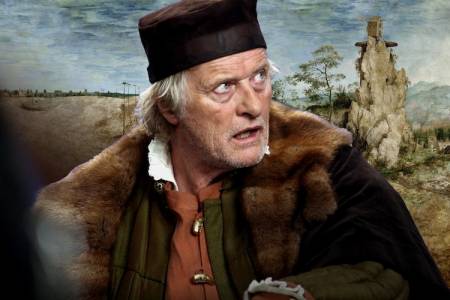
RUTGER HAUER AS PIETER BRUEGEL THE ELDER IN THE MILL AND THE CROSS
A sixteenth-century Flemish painting and its world brought to life on screen
Rutger Hauer, Michael York, and Charlotte Rampling are among the luminaries involved in the making of this strikingly beautiful as well as emotionally shattering art film recreating the making of a great painting. It's Pieter Bruegel the Elder's 1564 "The Procession to Calvary" (also known as "The Way to Calvary"), a panoramic vision showing both the Crucifixion of Christ and the brutalization of Bruegel's Flemish homeland by its contemporary Spanish occupiers. The Polish director Majewski uses state of the art techniques, including high-definition digital visuals, to bring the viewer, and his large cast in period costume, into the painting. The effect, says leading Variety film critic Dennis Harvey, may be enough (if the film is seen by the right audiences) to carry the director into the kind of international prominence enjoyed by Alexei Sokurov with his celebrated museum tour deforce, Russian Ark. Like Sokurov's single-take wonder, The Mill and the Cross isn't exactly a documentry, or an art piece, or a feature film; it's sui generis. On the other hand, some who saw this film at its Rotterdam screening felt that it "cried out for the 3D treatment" and without that "falls flat." This is the view of Hollywood Reporter's Neil young, who does, however, give the film, a Polish/Swedish co-production spoken (perhaps unfortunately) in English, credit for providing viewers with the full historical context of the painting.
Some of us are not passionate fans of the master Sokurov's museum tour de force to begin with, and there may be something initially distracting about the use of English and Michael York's initial voiceovers, which bring to mind his parodic turn in Austin Powers. But it's highyl debatable whether any screen situation ever cried out for the 3D treatment. Ultimately what happens here is just fine. The imaginative transfer of an artist's life on film has some of the luminosity of Peter Webber's Vermeer story, Girl With Pearl Earring, and some of the life and imagination of Derek Jarman's Caravaggio. (These are staged in English too, and the succeed because of their visual imagination.) However while it recreates the cruelty of the Spanish militia, who punish a supposed heretic by beating him mercilessly, strapping him to a wheel, and hoisting him high on a pole to have his eyes pecked out by crows, and dramatizes Bruegel's own household with a dozen wicked children dancing about in bedclothes, this film's primary and compelling focus in on the creation of this single painting.
Majewski has already established the menace of the Spanish militiamen with the horrific torture to death of the protestant. Now the danger they represent feels doubly real as the martyrdom of Christ is staged. Shooting in four different countries, Majewski builds up his scene with awesome verisimilitude and a brilliantly original sense of the particular detail. A triumph.
This film was shown at Rotterdam, and debuted at Sundance in January 2011, where it was well received. Seen and reviewed here in connection with the San Francisco International Film Festival, April 22-May 4, 2011.
SFIFF Screenings
Sat, Apr 23 12:30 / SFMOMA
Wed, Apr 27 9:00 / Kabuki
Last edited by Chris Knipp; 05-04-2015 at 10:13 PM.
-
Dan Geller, Dayna Goldfine: Something Ventured (2011)
Dan Geller, Dayna Goldfine: Something Ventured (2011)
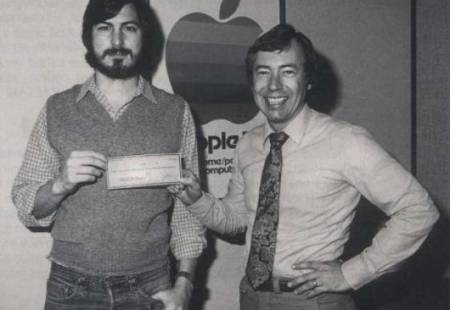
JOBS AND MARKKULA: THE FIRST CHECK.
The beginnings of venture capital and historic West Coast startups
Venture capital and its key role in tech startups over the past four decades are the topics of this little documentary. It describes the first venture capitalists, who funded funny little companies like Apple, Intel, Google, Genentech, Cisco, Tandem and Atari. This is the seventh film from the documentary team of Dayna Goldfine and Dan Geller (previous efforts have concerned Sundance, Isadora Duncan, and the Ballets Russes).
This begins with Arthur Rock, a Wall Street banker, in 1957, who funded "the Traitorous Eight," a group of engineers in California who broke away from William Shockley, the Nobel winning semiconductor guy, who was hard to work for. Rock seems to have invented the idea of venture capital, and the idea of a breakaway group of smart young guys starting their own company, both new ideas at the time. His bank's Wall Street wealthy weren't interested in investing in California, and a lot of big companies turned Rock down. But a a wealthy entrepreneur called Fairchild came up with the $1.5 million Rock was looking for, and Fairchild Semiconductor was born, in Mountain View. It was the beginning of Silicon Valley.
Maybe the next really significant story, after a lot of venture capital and startups and the growth of Silican Valley, is Kleiner Perkins in the late Seventies achieving success with Tandem Computers. (KPCB, Kleiner, Perkins, Caufield and Byers, begun by Eugene Kleiner, Tom Perkins, Frank J. Caufield, and Brook Byers in 1972, is the world's largest venture capital firm.) Tandem Computers broke away from the dominance of IBM and developed foolproof computers that are still used by Wall Street, airlines, credit card companies -- settings where computer breakdown and loss of data are not acceptable outcomes. Tandem became a Fortune 500 company. Kleiner Perkins began with an investment of $1.4 million in 1974, and sold Tandem to Compaq for $3 billion in 1997.
Next comes Atari and the eccentric Nolan Bushnell and "home Pong," the first compact non-coin operated computer game, which finally got going through Sears in 1975 after a hard time finding investors. Computer games now account for a third of all consumer entertainment spending in the US. Next big story: venture capitalist/promoter Bob Swansan and scientist Herbert Boyer and Genenech, the beginnings of genetic engineering, soon to be used to produce drugs on a vast scale and save hundreds of thousands of lives. And of course make tons of money. This is another thing of Kleiner Perkins, and the debonair, elegant Tom Perkins is one of the main narrators of the film's story. Genentech began with an investment of $250,000 (they kept it low by subcontracting the labs) in 1976, and ended for Kleiner Perkins when they sold Genentech to Roche for $47 billion in 2009.
These stories are all great and there's just one after another. Next, again 1976, the two Steves, Wozniak and Jobs, a scruffy, arrogant pair who tended to turn off investors, find Mike Markkula, retired at 32 from Intel, who comes out of retirement to find a tiny investment to get Apple started with a home computer. Arthur Rock, our starting point venture capitalist, is called in. Initial investments: Mike Markkula, $142,000, Arthur Rock, $57,000, and Don Valentine, $150,000. The 2010 market value of Apple? $220 billion. Nice return, eh?
Okay, but venture capital investments often fail, or bring only mediocre return, or just sit there and eat up investors' time and energy. Thus Power Point presentation software lost its backers, one guy took it on, and he and a few others sold it later to Microsoft. Their big mistake? The could have taken the buyout in Microsoft stock, but took cash, losing an untold amount of wealth they'd have gained if they'd taken shares in Bill Gates' company. Oh well.
Cisco Systems is an Internet story and a restructuring drama. The company run by a couple at home ran routers, which in 1984 didn't yet mean anything. Cisco is an example of the necessity of firing heads of companies for them to move forward. The founding couple were hard to deal with, and for the structure, the many vice presidents, to continue, they had to go, and they did. They went away, in their mid-thirties, with $170 million, but they have never forgiven the venture capitalists who okayed their removal. Sandy Lerner (the Cisco wife) went on to create a lot of other companies through investment. Cisco began with an investment by Sequoia of $2.8 million in 1987. It's 2010 value was $150 billion.
The stories are simple. And the conclusion is simple. Venture capital is nothing without entrepreneurship. But new things don't get started as well, or maybe not at all, without men with money willing to take chances on new ideas. Since 1960 the filmmakers figure venture capital has invested over $450 billion and started over 27,000 companies. As Atari founder Nolan Bushnell puts it, without venture capitalists, "the future wouldn't get started nearly as quickly." That's the useful message of this succinct 85 min. film. Something Ventured doesn't go into deep analysis of its stories. What about other personal computer ideas besides Apple, for instance? What about other venture capitalists besides its leading figures? But the film provides a straightforward survey of some of the major tech company startups and the role played by money in getting them going.
Seen and reviewed as part of the San Francisco International Film Festival, April-May 2011. A Zeitgeist Films release. This film debuted at the SXSW festival in Austin, Texas. (Film website here.)
SFIFF Screenings
Sun, Apr 24 2:00 / PFA
Sun, May 1 3:00 / Kabuki
Last edited by Chris Knipp; 08-26-2016 at 10:23 AM.
-
Mathieu Amalric: On Tour (2010)
Mathieu Amalric: On Tour (2010)
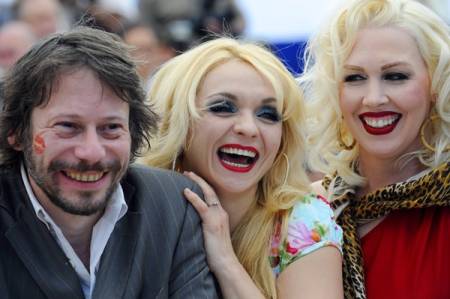
AMALRIC AND AMERICAN STRIPPERS IN ON TOUR
On the road, adrift, in France with American strippers
Big French star Mathieu Amalric's fourth directorial effort is an assured and atmospheric chronicle of a down-on-his luck TV emcee taking a group of American burlesque stars to lesser venues in France. The meandering On Tour/Tournée, with its nods to Robert Altman and Cassavetes' Killing of a Chinese Bookie, uses its hilariously voluptuous, past-their-prime American "New Burlesque" divas as its true mise-en-scene: the dismal French ports like Le Havre, Toulon and La Rochelle, anonymous hotels, and car and train interiors are as colorless as the dreary elevator music the impresario tries in van to have turned off. As Joachim, the beleaguered, distracted would-be producer, who can't get anybody to lend him a venue in Paris (or any other major French city, for that matter), sporting slick hair and a mustache, Amalric is a nattier, more durable, yet somehow less appealing version of the amiable neurotics he has played for director Arnaud Desplechin.
Because the mix doesn't entirely cohere, it's somewhat a mystery why the French critics have been universally ecstatic about On Tour. Its combination of sleazy urban French venues with the American accents and bodies of the burlesque queens may have woven a more special magic for them. It somehow served as a metaphor for the French fantasy relationship with the US. The French critics were also fascinated by the concept of "New Burlesque," in which the ladies capitalize on the quaintness and charm of their tantalizing art and weave inventive new acts that combine pasties with giant diaphanous balloons and adopt quasi-feminist stances, claiming they're women performing for women. They are Mimi le Meaux (Miranda Colclasure), Kitten on the Keys (Suzanne Ramsey), Dirty Martini (Linda Marraccini), Julie Atlas Muz (Julie Ann Muz), and Evie Lovelle (Angela de Lorenzo). The real live performance moments, which have a touch of Fellini and blend titillation with performance art, are all too brief. Mostly, and less successfully, divas merely play themselves off stage as they wait around, party late at hotels, pack up, or ride the train, and in those scenes they're not particularly interesting. Though Mimi le Meaux emerges as more verbal than the others, and also understands a bit of French -- slightly undercutting the general non-communication between Joachim and the girls -- even Mimi's scenes are merely background.
Half the screen time however, and gradually more and more of the attention, is devoted to Joachim's disheveled personal life, even though he barely has one and we never know quite how to take him. Former associates and ex lovers he approaches in Paris looking for a venue are angry and resentful, alternating between being vicious, passive-aggressive, and remote. A particularly painful love-hate relationship is with his brother François (played by director Damien Odoul). Heavy-handed viciousness comes from a theater owner (TV series creator Pierre Grimblat). A final appeal is to an ex girlfriend, now a cancer patient (Florence Ben Sadoun), a detail that lays it on a bit thick. Joachim's two cute sons (played by Simon and Joseph Roth), whom he takes on the road for a while but then neglects, are quite unimpressed by him. He makes love to the burlesque stars verbally once in a while, sometimes with drippy sentimentality. But he mostly neglects them as well, partly excused by their demand for artistic independence. Whatever the excuse, he is always off dealing with some new problem of his own. He repeatedly phones them on his mobile to explain his absence as they must pack up on their own along with male team member Rocky Roulette (Alexander Craven) and assistant Ulysse (Ulysse Klotz).
In his role as the protagonist Amalric winds up like the girls teasing the audience, offering little moments of charm (such as his flirting banter with a gas station attendant well played by Aurelia Petit) -- and the actor's trademark winsomeness, yet, through the sleazy outward surface, remaining essentially undefined. An essential crisis moment seems missing-- left out, perhaps, to give the burlesque performers the primacy the director insisted on at Cannes when he won the Best Director prize, and brought them all up on stage to accept it with him. Amalric seems throughout this film to accept his accustomed role of dominating the screen. But there needed to be a director to direct the director in his performance as protagonist, as well as a writer (despite four being listed) to define and focus the narrative. Cinematographer Christophe Beaucarne adeptly creates an effect that's half feature-half documentary, alternating closeups and wind-angle vérité-style long shots.
Tournée debuted at Cannes in May 2010, winning Amalric the Director's Prize. Apart from critical acclaim and respectable box office in France, the film has been shown at various festivals, with theatrical releases in many countries in Europe and elsewhere. It is also variously released on DVD. The San Francisco International Film Festival (May 2011) may be its last festival showing. Seen and reviewed in connection with the SFIFF.
SFIFF CLOSING NIGHT FILM:
Thu, May 5 7:00 / Castro
Last edited by Chris Knipp; 05-04-2015 at 10:21 PM.
-
Miranda July: The Future (2011)
Preview
Miranda July: The Future (2011)
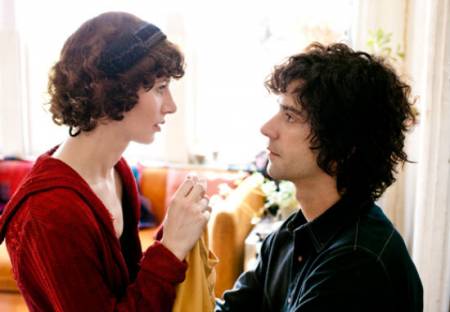
MIRANDA JULY AND HAMISH LINKLATER IN THE FUTURE
Existential decisions spurred by a wounded cat
Miranda July, whose 2005 Me and You and Everyone We Know had many admirers, is back with a grimly whimsical existential tale of a terminally tentative couple of thirty-five-year-olds, played by July herself and Hamish Linklater. July certainly has a distinctive style, a blend of the surreal and the mundane that seems to suit very well this story about quiet desperation in Los Angeles spurred by the doomed decision to adopt a cat that makes the pair separately revamp their lives.
Sophie (July) teaches dance to children, but isn't much of a dancer. It's about all she can do to slowly lift a bent leg with one arm extended. Jason (Linklater), whose uncertainty is balanced by a grounded manner and a deep voice, gives tech advice on the telephone, a job he’s willing to part with. The cat adoption is a major step for this wispy couple, who've been together five years. And the cat is special, a wounded, sick stray at the vet's called Paw Paw with perhaps six months to live, perhaps five years, depending on how much love and care he gets from his new masters. In the film’s most terminally whimsical streak July indulges in, Paw Paw has a running narration throughout, a monologue of brave desperation voiced by a squeeky-toned July. Archie and Mehitabel would hardly understand, but today's marginalized American middle class might get it and also understand the couple’s drift toward nowhere.
Sophie and Jason, who make a pretty cute couple despite their lack of focus or energy, and whose conversation often verges on the metaphysical, both quit their jobs. She has an affair with an older man who sells banners for conventions and who has a preternaturally articulate little girl who likes to dig trenches in the back yard. Jason takes a job canvassing for an ecology group selling trees door to door. He also befriends an old man who fixes electronic gadgets, and whose house seems full of the same objects he and Sophie have in their apartment. When Sophie starts to tell Jason about her affair, he freezes her on the floor and asks the moon for advice. All this seems pretty random, and you have to be a July-ite to like it. But July proceeds with bold assurance from one capricious inspiration to the next, and if you wind up deciding you've been had, it won't hit you right away, because the trajectory is quite inventive.
The Future debuted at Sundance in January 2011 and was in competition at Berlin and showed at SXSW. It opens in France in July, November in the UK. Seen and reviewed as part of the San Francisco International Film Festival, April-May 2011.
SFIFF Screenings
Sat, Apr 23 6:15 / Kabuki
Sun, Apr 24 9:15 / New People
Last edited by Chris Knipp; 05-04-2015 at 10:27 PM.
-
Florent Tillon: Detroit: Wild City (2011)
Florent Tillon: Detroit: Wild City (2011)
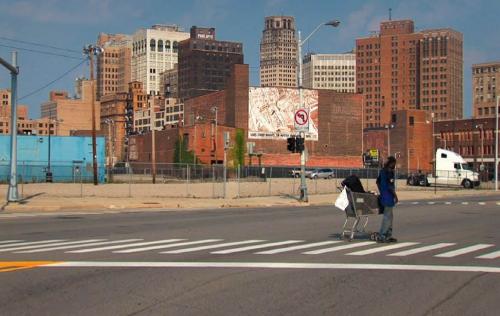
STILL FROM DETROIT: WILD CITY
A Frenchman's images of America's most devastated city
Obviously as the former center of the thriving American automobile industry earlier in the 20th century, Detroit, Michigan was once the most industrialized city in the United States, a symbol both of organized labor and of the wealth of great factory overlords. It also had racial and economic problems right from the beginning. And its reliance on a single industry sowed the seeds of its downfall in recent decades as America has outsourced labor and become increasingly post-industrial. The city's once-grand train station was closed long ago, along with its art-deco dance halls, and its residential neighborhoods fell into decline. Now, Detroit is the most dramatically devastated of all American cities. About half its population has fled. The automobile industry is largely dormant. Asphalt gives way to grass.
In French filmmaker Florent Tillon's neutral, quietly observant documentary about the present physical, financial, and psychic state of Detroit, the city appears clearly on the edge, either of rebirth or annihilation. He uses archival footage to hint at the city's former prosperity; his own camera explores the emptiness and decay and he interviews a few articulate observers who like to explore the ruins and remember what they once were. Some people take delight in the way the near-abandoned city's vast number of empty and decaying vacant lots, factory buildings, and residential neighborhoods stand as a model for a post-apocalyptic world. Others drive in and out of town on the freeway, going to work in the fortress-like Renaissance Center (built unsuccessfully to revitalize the city in the Eighties) and having no other contact with Detroit itself. Still others work in urban farms raising herbs and vegetables and dream of the return to a viable agrarian subsistence life. In the "wild city" Detroit, there are chickens and goats. How this will revitalize the whole town remains unclear. It's also not exactly clear how the work of "Blight Busters," whose young volunteer crews rush around the city demolishing derelict buildings at some risk to their own health, will lead to urban renewal.
The city garden projects reflect a hope that in the largely empty shell of the once-proud and vibrant Motor City ("Motown") there can be basic urban renewal. These urban pioneers are recreating life among the ruins. But this is only one narrative of the city. For the majority poor, black, and unemployed of Detroit, the present situation is hardly a hopeful one. On the other hand, there are people who see the rock bottom status of Detroit as fertile ground for new capitalist enterprise. The latter, however, Tillon eschewed as not reflecting the "poetic" view of the city he wanted to convey.
Detroit: Wild City neither analyzes nor intrudes, though it certainly edits out. Statistics are not presented, nor is the role of government, either local or national, taken into account. Whether the film is a portrait of disaster or rebirth ultimately remains ambiguous. The film is at its best when the camera merely surveys buildings and freeways, or follows individuals who like to explore the devastated factories or the long abandoned train station. For Tillon Detroit is not a plan or a statistic. It's a poetic landscape that may represent the future of capitalism, or the outcome of all human endeavor in the great scheme of things: dust to dust, back to the earth, as new insects and birds move in to occupy a changed eco-system. Though only partly shown here, Detroit now (according to the film's blurb) contains "vast urban prairies, populated with a diverse array of wildlife including falcon, deer, and coyote," which "have replaced what once had been working- and middle-class neighborhoods."
Tillon is a keen observer with a fine and poetic eye. But while Tillon's documentary focuses on the city as an entity by itself, his approach is obviously highly selective, and somewhat arbitrary. He might have presented a more thorough account of his urban story, but he chose not to do so. It's an interesting fact, but not one given here, that nine of Forbes' list of the 400 richest Americans live in Michigan; but none of them is named Ford. As a visual meditation this Parisian's visit to the ruins of Motor City may inspire conclusions and even action, but there is no attempt to place Detroit in the larger context of American cities, some of which, like Baltimore, for instance, suffered similar declines for similar reasons but have been brought back to life. The ruins of a city are still a city. It can hardly turn into something else. What are the chances that Detroit can be restored -- and how? At least without more detail and more energetic coverage and interviewing, Tillon's picture of the agrarian back-to-nature movement in Detroit offers only the most wan of hopes. The rest seems a romanticizing and aestheticizing of poverty.
Seen and reviewed as part of the San Francisco International Film Festival 2011.
See also the 2012 Detroit documentary Detropia.
SFIFF Screenings
Fri, Apr 29 7:00 / Kabuki
Sun, May 1 2:45 / New People
Wed, May 4 8:40 / PFA
Last edited by Chris Knipp; 08-13-2017 at 10:10 PM.
-
Nikola Lezaic: Tilva Rosh (2010
Nikola Lezaic: Tilva Rosh (2010)
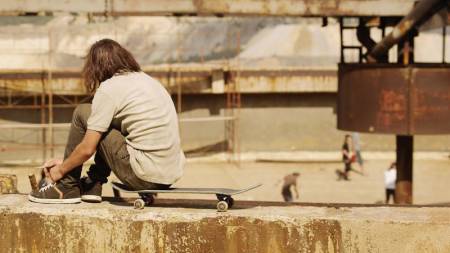
MARKO TODOROVIC IN TILVA ROSH
Serbian skateboarders enjoy a last summer of youth
The film focuses on a long-haired skateboarder skating down a pebbly hill (he says its name is "Tilva Rosh") and from the subtitles we learn Serbian has equivalents for words like "Nigga," "dude," and "wazzup." Toda and Stefan have just graduated from high school, and are spending the summer shooting Jackass-style videos of each other as they skate the empty former copper mine in their town of Bor (no pun intended) while waiting for one of them to go off to college.
The two guys are Toda/Marko (Marko Todorovic) and Stefan/Steki (Stefan Djordjevic). Steki is going to the University of Belgrade shortly. Toda/Marko isn't, and says he wouldn't even if he had the money. Toda hurts his head doing one of their stunts. Later whenn the boys sing at a shindig the emcee, whom they tease unmercifully, hits Toda again on the head, so he goes to the doctor. But he finds he's no longer covered as a student and must go to the factory to sign up for the bureaucracy to provide him with medical coverage -- a situation that sorely challenges his sense of youthful independence. He has to go to a CV preparation class or he won't get the benefits of the Employment Service.
Meanwhile a girl called Dunja (Dunja Kovacevic)) is back from France on summer holiday, and both boys themselves compete for her attention.
The "dudes" do the things young people do, get drunk, act wild, challenge and harass a new member before admitting him to the skate club. There are many little rites of passage, including self-imposed piercings and the brutal Jackass-style abuse Toda and Steki impose on each other. Later, they all get involved in a demonstration against the scam to privatize the mine.
These boys and their pals and parents and everybody on the scene may speak an odd dialect of Serbian, but the youthful rivalries, the desire to hang onto teenage freedom while the realities of the bigger world are in their faces, are elements of a universal coming of age story, and these two guys have an authentic loosely-slung quality that can't be faked. In fact they were discovered by the director (whose name is usually spelled Nikola Ležaić; the titles is spelled Tilva Roš in Serbian) when he came across their set of Jackass-style stunt videos, which they called Crap, and found them hilarious. Crap was like a dry-run mixtape for Tilva Roš. The circumstances leading up to the film are very much a part of the film and so is the depressed mining area the actors and filmmaker come from. Tilva Roš means "red hill," and Stefan explains in the opening scene that this place where they begin shooting, which was once a big hill, is now only a big empty hole.
Several things distinguish the film: the naturalness of the performances; the specific sense of place; the sense of solidarity and identity that the youths have as a group. This is also one of the best films for showing young people hovering between childhood and adulthood. A well-timed climactic moment comes in the rambling story when the guys are hassling the bald-headed emcee for hitting Toda (against the wishes of Toda, who wants to forget about it) when all of a sudden they wander into a big demonstration of workers, and the skateboarders fall in with the march. It's as if all of a sudden they consent to stop being slackers and turn into citizens. Steki jumps on a police car and is cheered for videotaping the demo from there. But only minutes later the whole posse -- over a dozen of them -- are skating through a big supermarket and trashing the aisles as Steki films that. They seem to be just taking advantage of the protest to act wild.
The risky stunts of Steki and Toda are great acts of camaraderie. Everybody appears to be having an awful lot of fun, and there's a loose, summery style that starts with the long hair and the loose clothes everybody wears. And this includes most of the parents and other adults, who are mostly represented as sympathetic and laid back.
The film is cleanly photographed and sparing in its use of music. Lezaic gets the maximum from his young actors, who are splendidly real as variations on themselves. This stands as an essential contribution to the cinema of twenty-first century youth.
Tilva Rosh has been in many festivals, beginning with Sarajevo (July 2010), where it won the grand prize, and most recently at Rotterdam, Miami and San Francisco. It was screened at the San Francisco International Film Festival for this review.
SFIFF Screenings
Thu, Apr 28 9:00 / Kabuki
Fri, Apr 29 9:15 / Kabuki
Mon, May 2 3:15 / Kabuki
Last edited by Chris Knipp; 05-04-2015 at 11:05 PM.
 Posting Permissions
Posting Permissions
- You may not post new threads
- You may not post replies
- You may not post attachments
- You may not edit your posts
-
Forum Rules





 Reply With Quote
Reply With Quote







Bookmarks